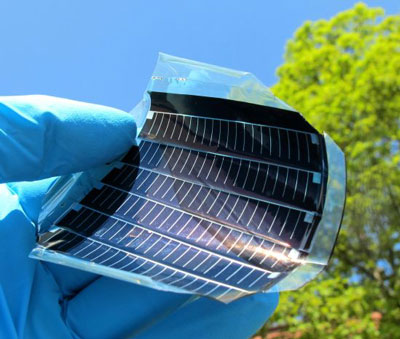| Jun 09, 2011 |
Efficiency record for flexible CdTe solar cell due to novel polyimide film
|
|
(Nanowerk News) Because Kapton® film is over 100 times thinner and 200 times lighter than glass typically used for PV, there are inherent advantages in transitioning to flexible, film-based vs. rigid glass CdTe systems. High-speed and low-cost roll-to-roll deposition technologies can be applied for high-throughput manufacturing of flexible solar cells on polymer film as substrates. The new polyimide film potentially enables significantly thinner and lighter-weight flexible modules that are easier to handle and less expensive to install, making them ideal for applications including building-integrated photovoltaics.
|
|
"Rather than transporting heavy, fragile glass modules on large trucks and lifting them by crane onto rooftop PV installations, one could imagine lightweight, flexible film-based modules that could simply be rolled up for transport, and easily carried up stairs," said Robert G. Schmidt, new business development manager, Photovoltaics - DuPont Circuit & Packaging Materials. "With record-setting efficiency established through Empa, we're confident this flexible, lightweight and durable material has the potential to revolutionize the industry by enabling flexible design and lowering balance of system costs."
|
 |
| Fully monolithically integrated flexible solar module (consisting of 6 cells) based on cadmium telluride (CdTe): Empa researchers recently achieved a new world record in energy conversion efficiency of 13.8 percent with this type of solar cell.
|
|
Increase in efficiency – toward achieving grid parity
|
|
Empa's Laboratory for Thin Films and Photovoltaics is developing high-efficiency thin film solar cells with emphasis on novel concepts for enhancing their performance, simplifying the fabrication processes, and advancing device structures for next generation of more efficient and low-cost devices. They have been doing groundbreaking work in developing and optimizing a low deposition temperature process (below 450 degrees Celsius) for high-efficiency CdTe solar cells on glass (reaching 15.6 percent efficiency) and polymer film (reaching 12.6 percent efficiency, the highest value before the recent improvement to 13.8 percent). Only a few weeks ago Tiwari's team also set a new world record in energy efficiency (of 18.7 percent) for another type of flexible solar cells based on copper indium gallium (di)selenide (also known as CIGS).
|
|
"Finding a film that could both be transparent and withstand high processing temperatures was a challenge initially, but the new Kapton® colorless polyimide film had both the tolerance for high temperatures needed, and higher light transmittance due to its transparency that allowed it to exceed our previous world record in conversion efficiency of flexible CdTe solar cell," said Ayodhya N. Tiwari, head of the laboratory. "As we continue to raise the standards for PV efficiency, materials make a distinct difference in the progress we make toward achieving grid parity. Of course, further development is needed for addressing cost and stability issues." Tiwari plans to present a technical paper on the full findings at the 26th European Photovoltaic Solar Energy Conference and Exhibition in Hamburg, Germany, being held Sept. 5, 2011.
|

